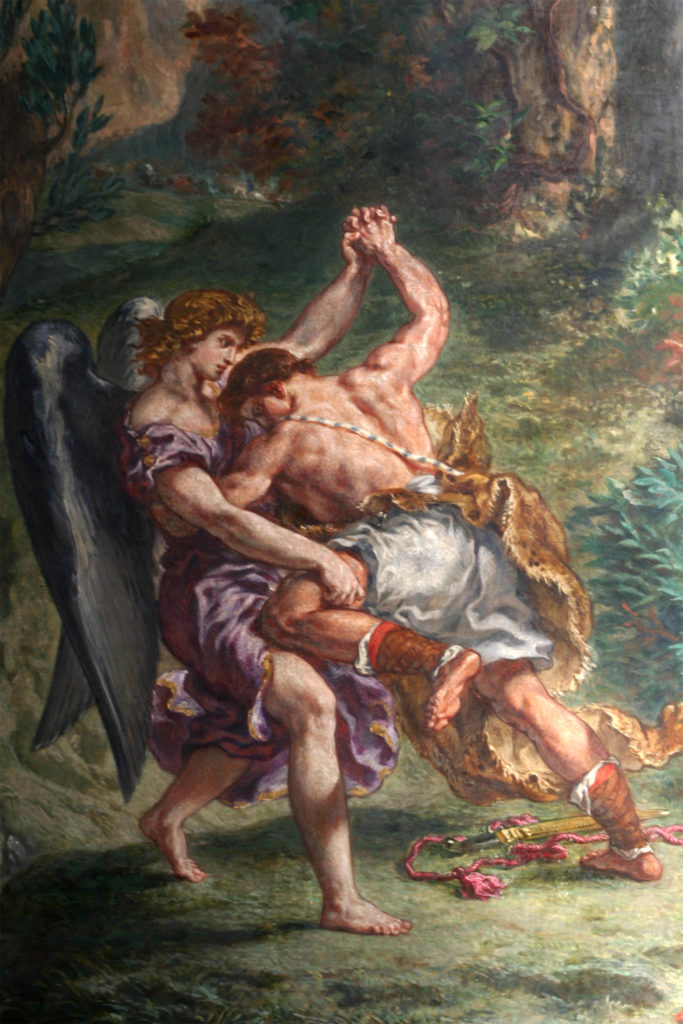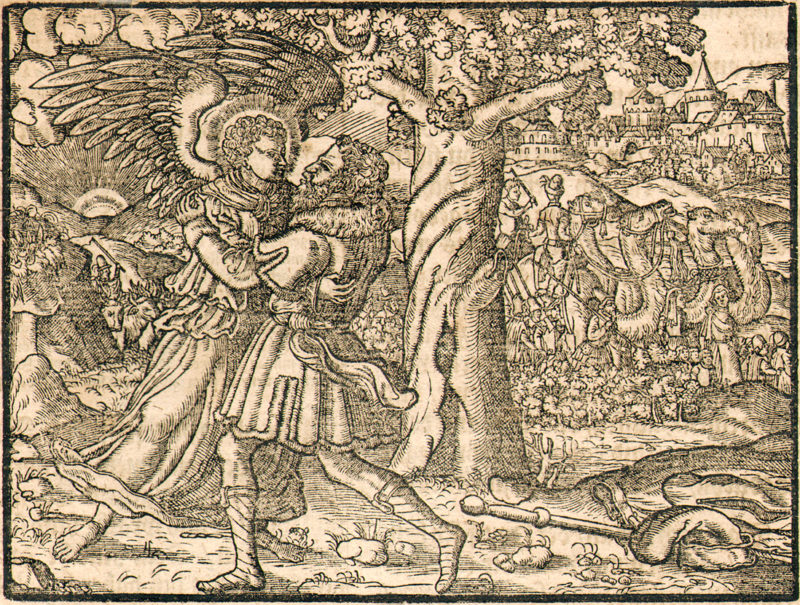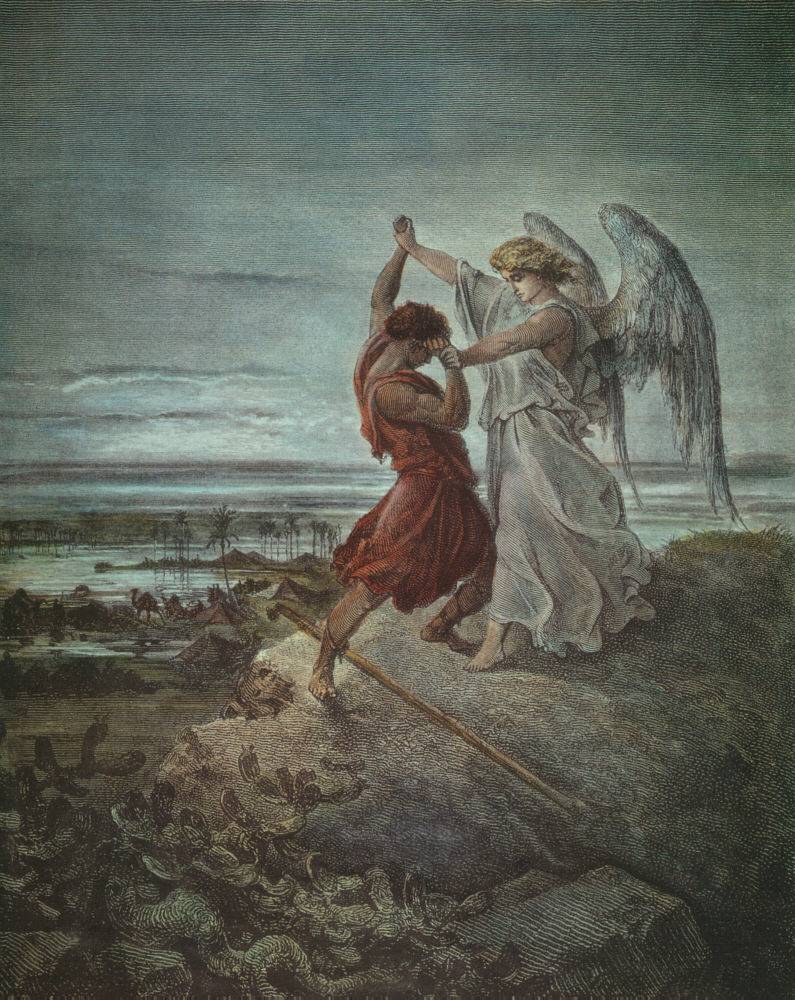So the present passed over before him; and he himself lodged that night in the camp. And he rose up that night, and took his two wives, and his two handmaids, and his eleven children, and passed over the ford of the Jabbok. And he took them, and sent them over the stream, and sent over that which he had. And Jacob was left alone; and there wrestled a man with him until the breaking of the day. And when he saw that he prevailed not against him, he touched the hollow of his thigh; and the hollow of Jacob’s thigh was strained, as he wrestled with him. And he said: “Let me go, for the day breaketh.” (Genesis 32:23–26)
The story of Jacob wrestling with a “man” is yet another of the Torah’s puzzling stories. Who was that “man” who wrestled with Jacob? The prophet Hosea identifies Jacob’s opponent as malakh, that is, an “angel”:
Yes, he had power over the angel, and prevailed. (Hosea 12:4)
Rashi and many other Torah commentators quote a midrash, according to which this angel was the guardian angel of Esau.[1] Maimonides, on the other hand, interprets the appearance of this angel as a dream or a prophetic vision of Jacob:
. . . the story about Jacob in regard to its saying, “And there was a man that wrestled with him”. . . all the wrestling and the conversation in question happened in the vision of prophecy.[2]
The Zohar maintains that the “man” represents the dark side of one’s psyche.[3] These are very different takes on the identity of the man who wrestles with Jacob. On some level, they are all true, and they point to an interesting and unexpected parallel in neuroscience.[4]
Let us parse this story. As Jacob takes his family over the river Jabbok,[5] he goes back and forth to move his belongings. The Torah says:
And he took them, and sent them over the stream, and sent over that which he had. (Genesis 32:24)
The midrash explains:
“What was his”: The animals and the movables. He made himself like a ferry-man, taking from here and depositing there.[6]
The Torah continues:
And Jacob was left alone (Genesis 32:25).
The midrash explains that Jacob forgot some trifling small objects and bottles and returned to retrieve them:
“And Jacob was left”: He had forgotten small bottles and returned for them.[7]
The Torah now tells us that Jacob encountered a “man” who wrestled with him:
. . . and there wrestled a man with him until the breaking of the day. (Genesis 32:25)
Our rabbis explain that this man was the prince (guardian angel) of Esau. Rabbi Chama bar Chanina said, “It was the prince of Esau.”[8]
Seeing that he cannot overcome Jacob through brute force, the man dislocates Jacob’s hip:
And when he saw that he prevailed not against him, he touched the hollow of his thigh; and the hollow of Jacob’s thigh was strained, as he wrestled with him (Genesis 32:26).
In the words of Rainer Maria Rilke:[9]
when his opponent’s sinews
in that contest stretch like steel,
he feels them under his fingers
as strings making deep melodies.[10]
The “man” then begs Jacob to let him go:
“Let me go, for the day breaketh.” (Genesis 32:27)
This moment in the struggle is beautifully captured by the American poet Emily Dickinson:
Till morning touching mountain—
And Jacob, waxing strong,
The Angel begged permission
To Breakfast—to return—[11]
As a result of Jacob’s injury, the Torah enjoins his progeny not to eat the gid hanasheh (of animals slaughtered for consumption) that corresponds to the sciatic nerve:[12]
Therefore the children of Israel eat not the sinew of the thigh-vein which is upon the hollow of the thigh, unto this day; because he touched the hollow of Jacob’s thigh, even in the sinew of the thigh-vein. (Genesis 32:33)

Thus far we have the biblical narrative of Jacob’s struggle with a “man” who wrestled with him. If we divorce ourselves from the literal meaning of this narrative and read it as an allegory,[13] this narrative seems to hint at the process of long-term memory consolidation in the brain as well as the process of forgetting. Let us review how neuroscience understands these processes.
In 1890, William James[14] was the first to distinguish primary memory, consisting of thoughts held for a short time in consciousness, and secondary memory, consisting of a permanent, unconscious store of memory.[15] In 1968, Richard Atkinson[16] and Richard Shiffrin[17] proposed the multi-store model consisting of three components:
- a sensory register, where sensory information enters memory;
- a short-term store, also referred to as working memory or short-term memory, which receives and holds input from both the sensory register and the long-term store; and
- a long-term store, where information is held indefinitely.
Multiple studies have shown that patients with bilateral damage to the hippocampal region could not form new long-term memories, although their short-term memory remained intact.[18] Short-term memory is primarily situated in the frontal lobe of the cerebral cortex. Long-term memory is primarily stored in the hippocampus.[19] This clear separation between short and long-term memories is symbolized by the river Jabbok, which separates two banks of the river. Indeed, in Kabbalah, Jabbok (Yabok) is often seen as a symbol of separation between good and evil[20] and between different levels in kedushah (“holiness”).
Generally, the symbolic association of Jabbok with memory becomes apparent from Moses’ blessings of the tribes before his death at the end of the Torah:
They shall teach Jacob Thine ordinances, and Israel Thy law; they shall put incense before Thee, and whole burnt-offering upon Thine altar. Bless, the Eternal, his substance. . . . (Deuteronomy 33:10–11)
As Rabbi Chayim Vital states in the name of the Ari, “the initials of the words for ‘they shall put incense before Thee’ (yasimu ketorah b’apecha) spell Yabok (Jabbok). Also, the sum of the numerical values of the initials of the words for ‘upon Thine altar; bless’ (al mizbechecha bareich) is the same as the numerical value of Yabok[21] (Jabbok).”[22] These words are directly preceded by the verse, “They shall teach Jacob Thine ordinances, and Israel Thy law,” which speaks of learning and memorization.
Current thinking is that memory consolidation occurs during sleep when daytime experiences are relived (rehearsed or reexperienced), resulting in dreams.[23] Important information and meaningful experiences are transferred from short-term to long-term memory. Episodic memory acquired during wakefulness is initially stored in the hippocampus. During sleep, bits and pieces of episodic memory are progressively transferred to the cortex as long-term memory. This process is symbolized in the biblical narrative by Jacob ferrying back and forth across Jabbok to transfer his belongings (new knowledge and episodic memory) from one bank of the river (short-term memory) to the other (long-term memory).
Less significant experiences are forgotten. The midrash alludes to this when Jacob returns to retrieve insignificant objects—“forgotten small bottles.” Jacob is careful not to forget even seemingly insignificant experiences (perhaps because he sees Divine providence in every experience), so he returns to retrieve them from short-term memory to take them across Jabbok to long-term memory.
As mentioned above, the process of consolidation happens primarily during sleep. It is believed that the rapid eye movement (REM) stage of sleep is when the day’s experiences are relived and dreams occur. In this stage, the brain reevaluates the significance of newly acquired information and new experiences for future use and for their worthiness of being stored in long-term memory. Researchers now believe that slow-wave sleep (SWS), which is deep, non-REM sleep, plays a significant role in long-term memory consolidation.[24] Regardless of the details, which are still not well understood, much of memory consolidation happens at night, during sleep. It may be symbolized by the part of the narrative telling us that Jacob’s ferrying back and forth across Jabbok occurred at night—“. . . and he himself lodged that night in the camp. And he rose up that night . . .” The struggle with the strange man also took place at night, “until the breaking of the day.” The allegory of sleep, as proposed here, is further reinforced by Maimonides, who asserted that Jacob’s encounter with the man was in a dream or prophetic vision.

But, who was that mysterious man? The midrash quoted by Rashi, which identifies the man as Esau’s guardian angel, and the Zohar, which identifies the man with our dark side, both associate the man with something negative. In our allegory, the man symbolizes the power to forget, which is “negative” vis-à-vis the power to remember.
Whereas one theory of memory holds that sleep aids memory consolidation, another competing theory holds that, during sleep, useless information and insignificant experiences are forgotten and purged from the brain. Recent research suggests that these theories do not conflict—both processes occur during sleep but in different stages.[25] Thomas Andrillon of the École Normale Supérieure (ENS) said:
[The] biggest surprise came from brain’s ability to unlearn. Thus, it seems that during sleep, we can either form new memories, learn, or do the reverse: suppress memories and unlearn.[26]
Whereas Jacob’s ferrying his belongings across the river Jabbok symbolized memorization and memory consolidation, his struggle with the man symbolizes the opposite process—forgetting.
In the words of Rabbi Chama bar Chanina, the man “was the prince of Esau.” In modern parlance, we might say that the man represents the principle of Esau. As we discussed earlier, in the essay, “Toledot: Jacob and Esau—Thermodynamics of Order and Chaos,” Esau represents the universe of Tohu (“chaos”), and Jacob represents the universe of Tikkun (“rectification”). Tohu—chaos—is related to forgetting, which destroys the orderly information and knowledge stored in long-term memory. Therefore, it is not coincidental that it is the principle of Esau that is used here as a metaphor for forgetfulness. It may also be hinted at in the dialogue between Jacob and the man:
And Jacob asked him, and said: “Tell me, I pray thee, thy name.” And he said: “Wherefore is it that thou dost ask after my name?” (Genesis 32:30)
Esau’s angel does not answer Jacob’s question. Perhaps he cannot answer the question because he does not remember his name. The inability of the man (or angel) who represents Esau to recall his own name may be an allegory of forgetfulness. The Zohar’s statement that the “man” represents the dark side could also allude to forgetfulness—the lack of or the “dark side” of memory.[27]
Jacob, on the other hand, represents the principle of memory. The Hebrew word for “memory” is zecher. This word has the same letters as the word zochar, that is, a boy. In Kabbalah symbolism, zochar is a euphemism for the partzuf Zeer Anpin (Z”A), the male principle of godliness.[28] As we discussed in the earlier essay “The Entangled Sisters,” partzuf Zeer Anpin is personified by Jacob. Thus, Jacob is the allegory for memory (zecher). The Torah hints at the association between remembering and Jacob, as it says:
And I will remember My covenant with Jacob (Leviticus 26:42)
The struggle between Jacob and Esau can, therefore, be seen as the struggle between remembering and forgetting, as the Torah says:
Remember, forget thou not . . . (Deuteronomy 9:7)
The man wrestled with Jacob until sunrise. This is an allegory of our daily struggle between remembering and forgetting. The ability to forget is critical for the healthy functioning of the brain. However, when it malfunctions, indiscriminate and uncontrolled forgetfulness leads to dementia, robbing patients of their personhood and eventually killing them. Esau, unchecked, represents unhealthy forgetfulness. That is why Jacob valiantly defended himself. Seeing that he could not prevail, the man managed to injure Jacob by dislocating his hip.
As a memorial to Jacob’s injury, as noted earlier, Jews are forbidden to eat the sciatic nerve (in Hebrew, gid hanasheh). This term appears later in the Torah, in the story of Joseph:
And Joseph called the name of the first-born Manasseh: “for G‑d hath made me forget all my toil, and all my father’s house.” (Genesis 41:51)
The word nasheh (from which the Hebrew name Menasheh—Manasseh—is derived) means “forgetting.” Thus, gid hanasheh may be translated as a “nerve” of forgetfulness. In addition to all other reasons for not eating gid hanasheh, we may not want to eat it so that we do not forget. As we age, we may forget some details, but we must never forget who we are, where we came from, and what our mission in life is. This is why the story ends with the man blessing Jacob and changing his name:
And he said: “Thy name shall be called no more Jacob, but Israel; for thou hast striven with G‑d and with men, and hast prevailed.” (Genesis 32:29)

The name Israel given to Jacob by the guardian angel of Esau, who admitted his defeat, hints at superior memory. First, Israel in Hebrew is Yisrael. According to Rabbi Chayim Vital, if we were to rearrange the letters, we can read Yisrael (yud-sin-reish-alef-lamed) as li rosh (lamed-yud reish-alef-shin)—that is, “a head for me.”[29] “A head for me” in this context means a perfect head, or a perfect mind. Second, as the midrash states:
Israel arose in [G‑d’s] thought. (Genesis Rabbah 1:4)[30]
The meaning of this verse is that G‑d remembered Israel.
As we can see from the example of Jacob wrestling with an angel, structural parallels between the Torah and science are not limited to quantum physics, but are also found in neuroscience and other natural sciences. Let us not forget that.
————————–
Endnotes:
[1] The guardian angel of Esau is identified with Samael, the archangel who is the seducer, accuser, and executioner (Satan). See Talmud, tr. Sotah 10b.
[2] Maimonides, The Guide for the Perplexed, 2:42.
[3] Zohar 1:170b.
[4] To be sure, this allegorical interpretation is far removed from the literal meaning of the text, peshat. However, biblical hermeneutics has different levels of exegesis called Pardes: peshat (“literal meaning”), remez (“allegory”), derush (“homiletics”), sod (“secret”), and sod shebe sod (“secret of secrets”). Our proposed interpretation falls squarely into the second level—remez—which entails hints and allegories.
[5] The river Jabbok is identified with the Zarqa River, the second largest tributary of the lower Jordan River. See Michael David Coogan, “The Oxford History of the Biblical World” (Oxford University Press, 2001), p. 10.
[6] Genesis Rabbah 75:9.
[7] Genesis Rabbah 77:2, Talmud, tr. Chullin 91a.
[8] Genesis Rabbah 77:3, 78:3.
[9] Rainer Maria Rilke (1875–1926), a Bohemian-Austrian poet, was one of the greatest lyric German-language poets.
[10] Rilke, The Book of Images, “The Man Watching,” translated by Edward Snow (North Point Press, 1991).
[11] Emily Dickinson, “A little East of Jordan,” (1860) J59, https://digitalemilydickinson.weebly.com/a-little-east-of-jordan.html, retrieved December 5, 2020.
[12] Talmud, tr. Chullin, ch. 7.
[13] This is not to deny the literal meaning of the Torah narrative but rather to add to it, since every verse can be interpreted on allegorical, homiletical, and mystical levels in addition to literally. See footnote 4 above.
[14] The American philosopher and psychologist William James (1842–1910) is considered the father of American psychology and one of the most influential American thinkers.
[15] William James: Writings 1878–1899, The Library of America (retrieved December 3, 2020).
[16] Richard Chatham Atkinson (b. 1929) is an American professor of psychology and cognitive science. He is president emeritus of the University of California system, former chancellor of the University of California, San Diego, and former director of the National Science Foundation.
[17] Richard Shiffrin (b. 1942) is an American psychologist and professor of cognitive science in the Department of Psychological and Brain Sciences at Indiana University.
[18] See, for example, Jeroen G. W. Raaijmakers, “The Story of the Two-Store Model of Memory: Past Criticisms, Current Status, and Future Directions,” in Attention and Performance, vol. 14 (MIT Press, 1993), pp. 467–488 (retrieved December 3, 2020).
[19] This is a bit of oversimplification. Modern neuroscience holds that all brain functions are distributed among different lobes and neuronal groupings. Memory is distributed across various areas of the brain as well. However, it is undisputed that the hippocampus plays a critical role in the formation and consolidation of long-term memory.
[20] See Rabbi Moshe Wisnefsky, “Apples From the Orchard: Gleanings From the Mystical Teachings of Rabbi Yitzchak Luria (the Arizal) on the Weekly Torah Portion” (Thirty Seven Books, 2006), p. 185.
[21] The numerical value (gematriah) of Yabok (Jabbok), spelled yud-bet-quf, is 112. The numerical values of the initials of the verse are ayin=70, mem=40, and bet=4—the total of which is also 112.
[22] Shaar HaPesukim and Likutei Torah, parshat Vezot HaBerachah. See also Rabbi Moshe Wisnefsky, p. 1057.
[23] S. Ruch, O. Markes, B. S. Duss, D. Reber Oppliger, T. Koenig, J. Mathis, C. Roth, and K. Henke, “Sleep Stage II Contributes to the Consolidation of Declarative Memories,” Neuropsychologia (2012), 50 (10): 2389–2396.
[24] See, for example, Wei, G. P. Krishnan, and M. Bazhenov, “Synaptic Mechanisms of Memory Consolidation During Sleep Slow Oscillations,” Journal of Neuroscience, 2016; 36 (15): 4231. doi: 10.1523/JNEUROSCI.3648-15.2016
[25] See, for example, Thomas Andrillon, Daniel Pressnitzer, Damien Léger, and Sid Kouider, “Formation and Suppression of Acoustic Memories During Human Sleep,” Nature Communications, 8, 179 (2017).
[26] Ana Sandoiu, “How Sleep Helps Us to Remember and Forget at the Same Time,” Medical News Today, August 9, 2017, https://www.medicalnewstoday.com/articles/318887, retrieved December 3, 2020.
[27] In Kabbalah, forgetfulness is seen a kelipah, that is, a force of evil. Moreover, Kabbalah speaks of the angel of forgetfulness whose name Mas is made of two letters—mem and samech. See Rabbi Moshe Wisnefsky, p. 874. Interestingly, the Talmud identifies the guardian angel of Esau with Samael, who, in the vernacular, is called Samech-Mem—the same letters that make up the name of the angel of forgetfulness.
[28] See Rabbi Moshe Wisnefsky, p. 871.
[29] Rabbi Moshe Wisnefsky, p. 246.
[30] Ibid.
